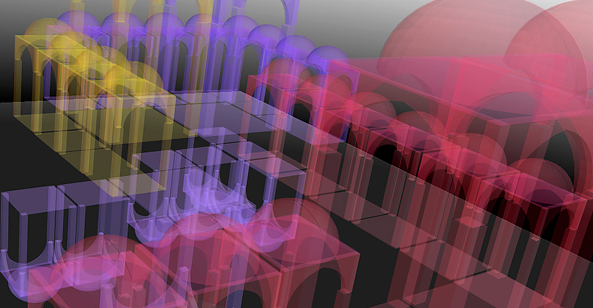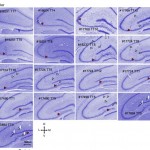Memory was considered the greatest faculty of mind before the invention of printing. Greek philosophers, Roman lawyers and Medieval European priests practiced the art by storing memories within mentally constructed architecture and objects. Recently, a study has found that rooms may be just how memory is stored.
“Each place–or room in your house–is represented by a unique map or memory and because we have so many different maps we can remember many similar places without mixing then up,” Dr. Charlotte Alme, PhD student Kavli Institute for Systems Neuroscience/Centre for Neural Computation Medical Technical Research Centre at the Norwegian University of Science and Technology (NTNU) and lead researcher on the study, told The Speaker.

“[W]e just published a paper where we see that rats–and most likely humans–have a map for each individual place, and this is why the method of loci works.”
“Episodic memory is characterized by an apparently astronomical storage capacity,” the reserachers framed their study, commenting on the thousands of new experiences that are encoded in the mind every day. These memories are thought to be stored on neural network properties of the hippocampus.
Alme provided some basic context for understanding the work.
“Memories are thought to be stored in physical networks of neurons that are connected to each other. Memories consist of many sensory pieces of information that are associated–when our brain encodes a personal experience, something in common is: what happened where and when.
“The connections between the neurons involved in encoding an experience are modified and strengthened in order to make a memory for that event. This means that when we years later smell an odor for example, we can remember the whole episode just by getting a cue–the odor–presented.
“We know now that the hippocampus is involved in formation of episodic–autobiographical–and spatial memories, in both humans and rats. The hippocampus is an evolutionarily very old part of the brain, conserved across mammals. Accordingly, we can investigate the spatial component of memory in rats and at the same time figure out how our memory system works. We have known for a long time that there are place specific cells in the hippocampus.
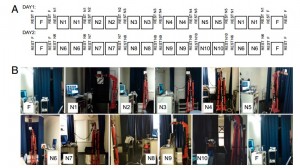
“The place cells that are active in restricted areas of an environment are also reactivated if a rat–or a human–experiences a previously known location–the place cell fires at the exact same location meaning that a memory for that particular place is formed. When a rat is placed in a different room, the place cell changes its firing location and that tells us that the rat knows it is in a different room.”
The current research, Alme said, was a matter of conducting a test to validate one of two possible theories.
“We wondered, what happens if we introduce many very similar rooms to a rat while we look at the firing response of the place cells. Will we see a generalization over all–or some–of the environments so that many place cells fire at the same location across all the rooms? Alternatively, the rat will create unique maps for each location and thus be able to separate between many and very similar experiences. Indeed, we observed the latter scenario because we can combine the 11 rooms in 55 ways to compare the rooms with each other, and when none of the room representations or memories overlap, this tells us that we have an enormously large storage capacity for memories in the brain.
In the research, the team found a complete lack of any overlap between spacial maps despite exposing the animals to a range of rooms with similar sensory features, which means that CA3 place cells may well form unique spacial representations for every single environment.
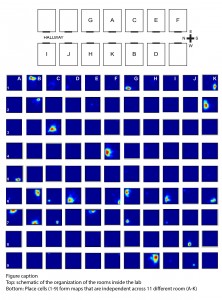
“We recorded from on average 50 neurons in each rat and the rat hippocampus consist of hundreds of thousands of cells, in other words we can create and store very many memories throughout our lifetime.”
The team did not in their research find evidence to make detailed guesses about the bounds of memory capacity in CA3.
The work has important implications for the traditionally practiced arts of memory. Throughout history, people accross cultures have developed and trained themselves in nmemonic arts that are based on mentally constructing physical architecture and objects. For example, Romans would search through a mental apartment until they found a piece of legislation, and Medeival monks would memorize sermons by organizing important aspects of those sermons as mental objects stored appropriately in mental architecture.
“The findings of our paper also help to explain how the ancient Method of Loci works. Because we are extremely good at remembering places and because we are very visual creatures, this combination can be utilized when you want to remember something.
Alme explained how this can work.
“Associate what you want to remember to a place that you know well, e.g. your own house. Your own house consists of several rooms, or 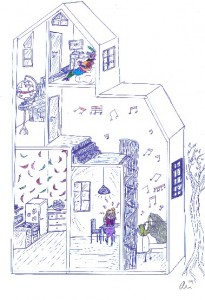 loci. Create a mental path through your house and in each room you connect or associate what you want to remember with something you place in that room. When you have made all the associations, you can recall or remember everything by taking a mental walk through your house again.
loci. Create a mental path through your house and in each room you connect or associate what you want to remember with something you place in that room. When you have made all the associations, you can recall or remember everything by taking a mental walk through your house again.
“For example as this cartoon shows: in the kitchen there are chilies flying in the air, the country to remember is Chile. Next to the kitchen, in the dining room your friend Tina is very angry–Argentina. In the living room there is a seal playing bras, Brazil. Up the staircase there is a Globus with a red band around equator–Ecuador. In the attic Columbus is lying on a bed watching TV–Columbia.
 “You create your own associations, the stranger the associations the easier they are to remember!”
“You create your own associations, the stranger the associations the easier they are to remember!”
The research has pushed forward our understanding of how memories are stored in place cells in the hippocampal area CA3. It had not been known whether the cells maintain independence when the number of memorized environments is increased.
The report, “Place cells in the hippocampus: Eleven maps for eleven rooms,” was completed by Charlotte B. Alme, Chenglin Miao, Karel Jezek, Alessandro Treves, Edvard I. Moser, and May-Britt Moser, a join-team of researchers from the Norwegian University of Science and Technology’s (NTNU) Kavli Institute for Systems Neuroscience and Centre for Neural Computation along with colleagues from the Czech Republic and Italy, and was published on the Proceedings of the National Academy of Sciences (PNAS) website.
Images: the work of the researchers, Nature Reviews, the Palace Project
Additional images
